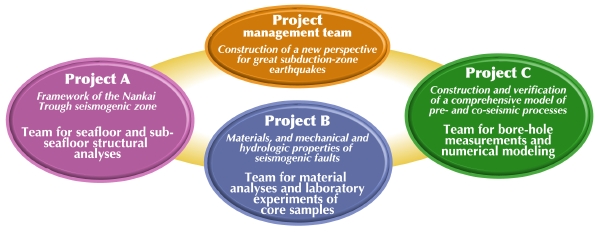Project

Outline
To achieve our science objective of ascertaining a new perspective on great subduction-zone earthquakes, we have organized three projects (A, B and C), each of which is composed of two complementary sub-projects (01 and 02).
Project A: Framework of the Nankai Trough seismogenic zone
Sub-project A01: 3D structures and physical properties of seismogenic faults
Sub-project A02: Recent activity of seismogenic faults
Project B: Materials, and mechanical and hydrologic properties of seismogenic faults
Sub-project B01: Mechanical and hydrologic properties of seismogenic faults
Sub-project B02: Materials and slip processes of seismogenic faults
Project C: Construction and verification of a comprehensive model of pre- and co-seismic processes
Sub-project C01: In situ borehole measurements of physical conditions and properties
Sub-project C02: Comprehensive modeling of pre- and co-seismic processes
Project A
Sub-project A01: 3D structures and physical properties of seismogenic faults
In 2006, 3D seismic reflection data covering the NanTroSEIZE drilling sites was obtained via a Japan-U.S. joint survey. Coring and borehole logging were conducted during NanTroSEIZE stages 1 and 2, and are planned during the future stage 3. This sub-project will reveal detailed 3D structures of seismogenic faults based on high-precision image processing of the 3D reflection data. Moreover, the physical properties of seismogenic faults will be analyzed by vertical seismic profiling (VSP) experiments within the drill holes. In addition, the hydrologic properties of seismogenic faults, including the spatial distribution of fluids and fluid pressures, will be evaluated by integrating the above data with the results of sub-projects A02 and C01.
Sub-project A02:
High precision topographical/geological surveys for elucidating the activity history of seismogenic faults
The complex trench-slope topography of the Nankai Trough likely formed through accumulated displacements by repeated faulting as well as modifications by failures of unstable slopes. Stage 1 of NanTroSEIZE found numerous submarine-sliding deposits repeatedly cut by faults. Additionally, the characteristic deformation structure suggestive of a strong oscillatory motion was observed in the shallow hanging-wall of a seismogenic fault. These observations suggest that the seafloor-topography and shallow deformation structures may record valuable information about recent seismic activities. In this sub-project, the topographic features induced by faulting and/or sliding will be characterized by seafloor and sub-seafloor geodetic/geologic surveys as well as core sampling of seafloor mud with high-precision, which will enable along-depth information from drill hole data to be extended laterally. Furthermore, the fluid behavior along seismogenic faults will be estimated by monitoring fluid fluxes and chemical variations. These data will be compared with the results of sub-projects A01 and C01.
Project B
Sub-project B01: Mechanical and hydrologic properties of seismogenic faults
NanTroSEIZE will obtain continuous core samples down to seismogenic depths of the plate-boundary fault and the mega-splay fault. This sub-project will conduct laboratory experiments on core samples at their in situ physical conditions obtained by sub-project C01 to determine the mechanical and hydrologic properties of faults at seismogenic depths as well as variations in these properties with depths within the accretionary prism. These data will then be combined with the results of sub-project B02 to understand the seismogenic conditions and processes in the Nankai subduction zone. The experimentally determined mechanical and hydrologic properties will be used as parameters for numerical modeling in sub-project C02.
Sub-project B02: Materials and slip processes of seismogenic faults
The drilling program of the Nankai Trough seismogenic zone will yield core samples from both seismic and aseismic parts of the plate-boundary fault and the mega-splay fault. This sub-project will structurally, mineralogically, and geochemically analyze fault samples to reveal slip, failure propagation, and energy dissipation processes during seismic, aseismic and tsunamigenic faulting. In addition, deformation mechanisms and fluid–rock interactions of the host rock samples will be analyzed to elucidate strain-energy accumulation and release processes in the Nankai accretionary prism.
Project C
Sub-project C01: In situ borehole measurements of physical conditions and properties
In situ monitoring of parameters such as stress, pore-fluid pressure, and temperature will determine the physical properties and conditions of seismogenic faults and their host sediments. Both logging and core analyses in NanTroSEIZE stage 1 have revealed a 90° rotation of the maximum horizontal compressive axis across mega-splay faults. This project will estimate confining pressures as well as maximum compressive stresses using the first sub-seafloor stress measurements. Additionally, the in situ permeability and Skempton’s coefficients will be determined by water-injection experiments and leak-off tests. These data along with pore-fluid pressure and temperature data will be used to infer fluid migrations and volumetric-strain variations. Borehole measurements of S-wave and surface-wave velocities will determine rigidity moduli and Poisson’s ratios, while seismic structures around the faults will be inferred by active-source experiments conducted with sub-project A01. Inter-seismic changes in the physical properties as well as conditions of the seismogenic faults and their host sediments will then be modeled by collaborating with sub-project C02.
Sub-project C02: Comprehensive modeling of pre- and co-seismic processes
Detailed structures of the shallow part of the Nankai subduction zone, including physical properties, temperatures, stresses, and fault geometries, will be revealed by the above sub-projects. This sub-project will construct a comprehensive model of pre-seismic and dynamic-rupture processes along the seismogenic faults based on the valuable information thus obtained. Moreover, complicated deformation processes in the shallow part of this subduction zone, including formation and deformation processes of accretionary wedge structures, long-term variations in stress and temperature, and interrelations between slow deformations and high-velocity dynamic deformations, will be numerically modeled. Furthermore, this model will be used to assess the possibility of predicting processes leading to great subduction-zone earthquakes. The results will provide feedback for future long term borehole monitoring.


 HOME
HOME KANAME Office
KANAME Office